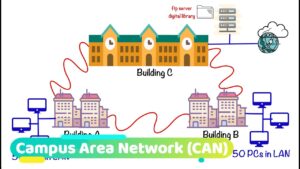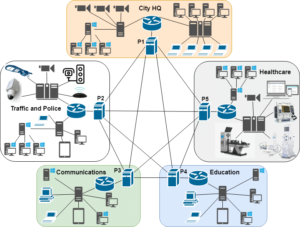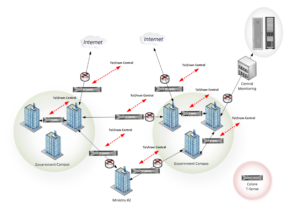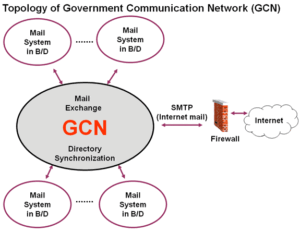Metropolitan Area Network is a network coverage that people always confuse with Wide Area Network.
Metropolitan Area Network is a network used for interconnecting network devices within a metropolitan area like a city, urban area, or rural area.
MAN normally covers a distance of 2km to 10km. This coverage is way less than WAN, which covers up to 100 km, but way higher than LAN, which normally exists within a local area (distance from meters to a 1km).
In this post, I will be working you through five examples of a metropolitan area network and brief explanation of each of them.
5 Examples of Metropolitan Area Networks
Here are five examples of metropolitan area networks;
1. Campus Network
Campus Network is one of the perfect examples of MAN. Campuses usually have their buildings and branches distributed within a metropolitan area.
Any campus will have a central administration building or headquarters. In this headquarters, servers host critical applications, databases, and collaborative platforms essential for academic and administrative functions. And this is where the internet service obtained from the ISP usually goes directly.
This connectivity is extended from the headquarters to various academic buildings, libraries, secondary schools under the campus, other branch campuses and research centers dispersed throughout the campus (metropolis). Fiber-optic cables or radio devices are used to distribute this connectivity from the headquarters to other branches.

Lecture halls, laboratories, and dormitories benefit from high-speed connectivity. This helps students and faculty access educational resources efficiently.
2. Healthcare Information System
A health care system can also have branches that are distributed within a metropolitan area. The branches may involve multiple health care centers and clinics. These branches need to be interconnected using healthcare information systems.
In a healthcare information system, the central data center acts as the headquarters. Here, patient records, medical databases, and diagnostic tools are securely stored and managed.
The Healthcare Information System connects hospitals, clinics, and specialized healthcare facilities across the metropolitan area.
Fast and reliable networking enables healthcare professionals to access patient information promptly, share diagnostic results, and collaborate on treatment plans.
3. Smart City Infrastructure Network
A network can also be deployed to interconnect the devices used in the smart city infrastructure. This infrastructure will comprise devices like sensors, automatic switchable street lights, and cameras.
At the center of a smart city infrastructure network lies a centralized data hub. Here, data from various sensors, surveillance systems, and city services converge, forming the backbone of smart city operations.
This information is then extended to different sectors, including transportation, public safety, and environmental monitoring.

For instance, traffic management systems, connected streetlights, and waste management facilities are interlinked through the MAN. This enables real-time data exchange, fostering a responsive and sustainable urban environment.
4. Government Communication Network
The government can also interconnect branch offices within a state or local government area.
If the government network were deployed at the state level, it would need to be extended to other lower tiers of the government, like zonal regional offices or local government area offices.

Source: celarenet.com
The office residing at the state level forms the central hub of the communication network. Here, sensitive data, communication tools, and administrative applications are hosted.

Source: ogcio.gov.hk
The connectivity is extended to various government agencies and departments within the metropolitan area. This facilitates efficient communication, secure data sharing, and collaboration.
5. Citywide Wi-Fi Network
Some developed cities can also deploy a network that provides connectivity to citizens or any organization residing in that metropolis.
The data center is built in a convenient location, like a location closer to the ISP, and the connectivity is then extended to public spaces, commercial districts, and residential areas.

Source: researchgate.net
Access points strategically placed throughout the city ensure that residents, businesses, and visitors have reliable and high-speed internet access. The network promotes digital inclusion and serves as a catalyst for economic development.
Conclusion
There are many examples of metropolitan area networks around us. Even though they have multiple routers located at each branch, like a wide-area network, it has less coverage and a relatively smaller amount of routers than a WAN.
Metropolitan Area Networks are not only deployed in urban areas, as many people think. It can also be a network deployed in an urban area.

I am a passionate Networking Associate specializing in Telecommunications.
With a degree in Electronic engineering, I possess a strong understanding of electronic systems and the intricacies of telecommunications networks. I gained practical experience and valuable insights working for a prominent telecommunications company.
Additionally, I hold certifications in networking, which have solidified my expertise in network architecture, protocols, and optimization.
Through my writing skills, I aim to provide accurate and valuable knowledge in the networking field.
Connect with me on social media using the links below for more insights.
You can contact me using [email protected] or connect with me using any of the social media account linked below




Hello,
This is a very insightful and informative writeup…..do you have any live case studies or projects for smart city infrastructure or corporate metropolitan/city wide network service ?